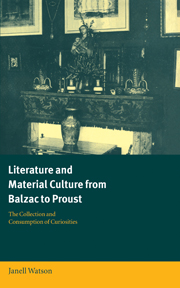Book contents
- Frontmatter
- Contents
- Acknowledgments
- Introduction
- Chapter 1 The bibelot
- Chapter 2 The logic(s) of material culture
- Chapter 3 The fashionable artistic interior
- Chapter 4 Flaubert's “musées reçus”
- Chapter 5 Narrate, describe, or catalogue?
- Chapter 6 The parlour of critical theory
- Chapter 7 Rearranging the Oedipus
- Notes
- Bibliography
- Index
- CAMBRIDGE STUDIES IN FRENCH
Chapter 3 - The fashionable artistic interior
Social (re)encoding in the domestic sphere
Published online by Cambridge University Press: 22 September 2009
- Frontmatter
- Contents
- Acknowledgments
- Introduction
- Chapter 1 The bibelot
- Chapter 2 The logic(s) of material culture
- Chapter 3 The fashionable artistic interior
- Chapter 4 Flaubert's “musées reçus”
- Chapter 5 Narrate, describe, or catalogue?
- Chapter 6 The parlour of critical theory
- Chapter 7 Rearranging the Oedipus
- Notes
- Bibliography
- Index
- CAMBRIDGE STUDIES IN FRENCH
Summary
The myth of the artist and the cult of art so permeate nineteenth-century French literature and criticism that Claude Duchet suggests revising the familiar schema for periodizing French studies by century: he places the “paradigme de ‘l'artiste’” between “l'ère des ‘philosophes’ et l'avènement de ‘l'intellectuel’.” The private dwelling becomes an important site on which the nineteenth-century “paradigme de ‘l'artiste’” is played out, for during this period, artistic sensibility is commonly manifested by an appreciation of the “minor” arts of interior furnishing and decor, fueling the popularity of collecting and the bibelot. To launch an inquiry into the relationship of the philosophe or the intellectual to interior decor would be ludicrous; however, many of the writers of the era of the artist take decor very seriously and write about it at length, often dramatizing the sociology of aesthetic judgment in fiction and non-fiction. Issues of class and gender complicate matters: the image of the artist appeals to social groups from whom a mostly male cultural elite strives to distance itself, the bourgeoisie and women. The home interior thus becomes a field of struggle for claims to artistic taste. At the heart of this struggle one finds the bibelot in its various guises – objet d'art, objet de luxe, objet de mode, objet superflu, objet de consommation, objet de désir.
The lengthy descriptions of interior decor characteristic of nineteenth-century novels are best understood within the context of both the sociology and the aesthetics of the decorative arts.
- Type
- Chapter
- Information
- Literature and Material Culture from Balzac to ProustThe Collection and Consumption of Curiosities, pp. 57 - 82Publisher: Cambridge University PressPrint publication year: 2000

